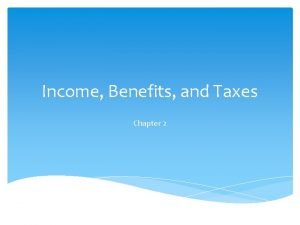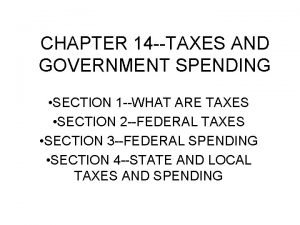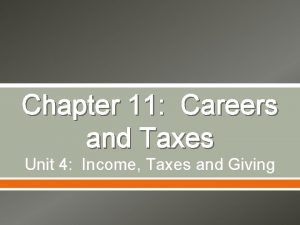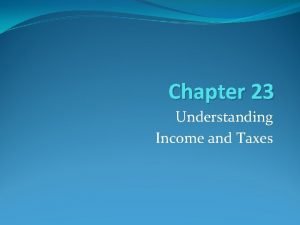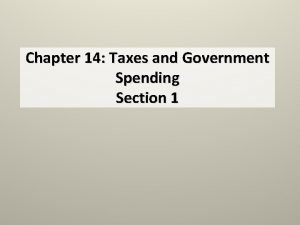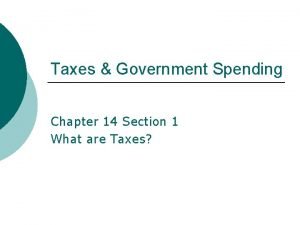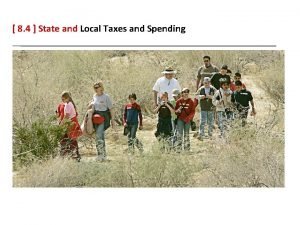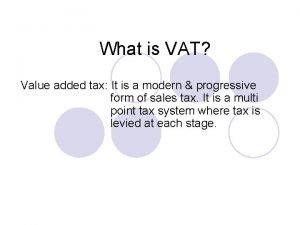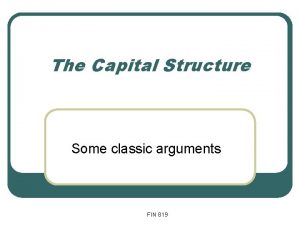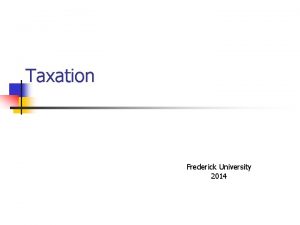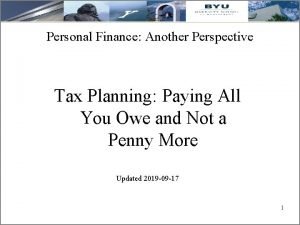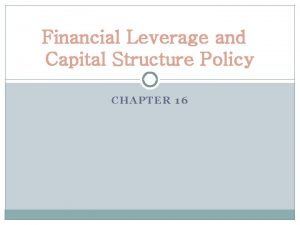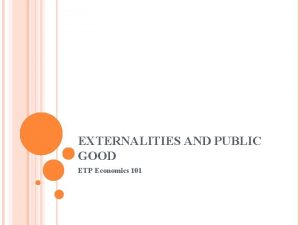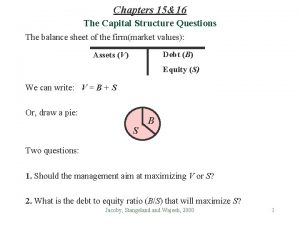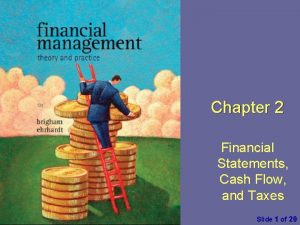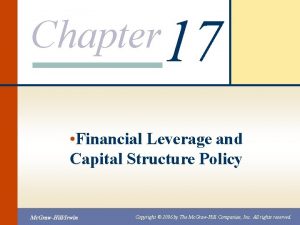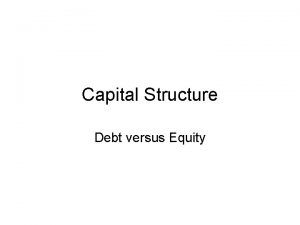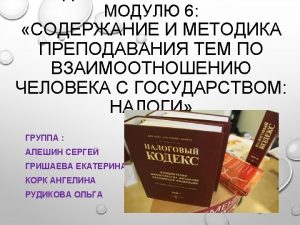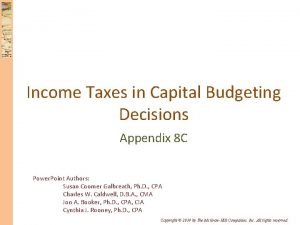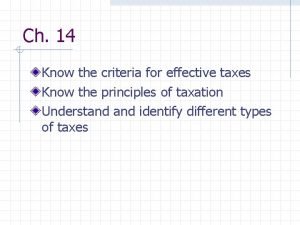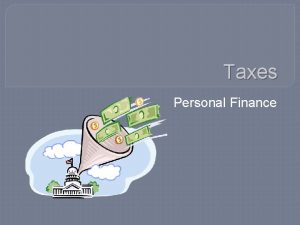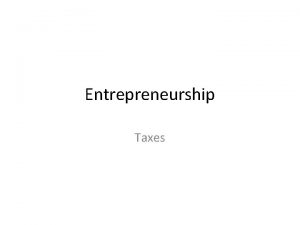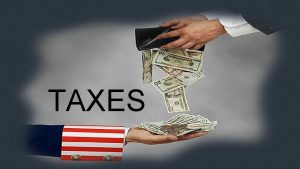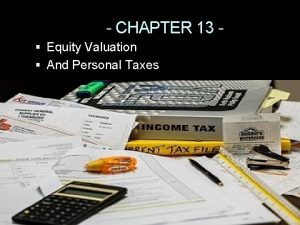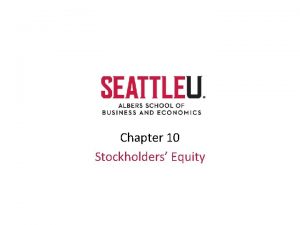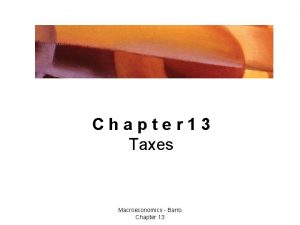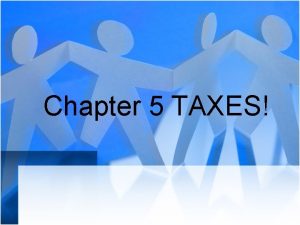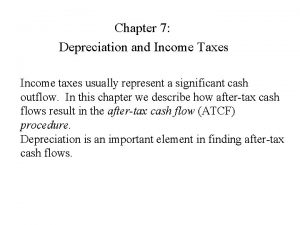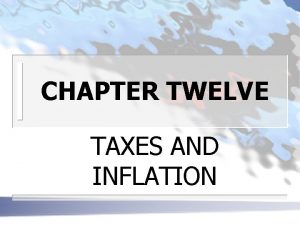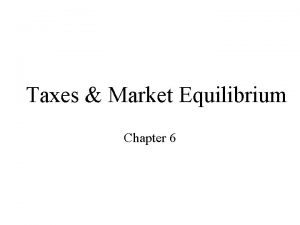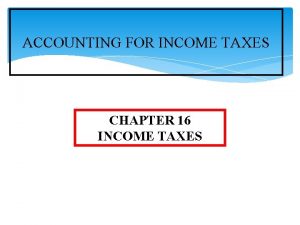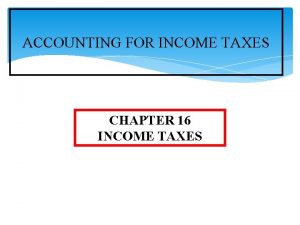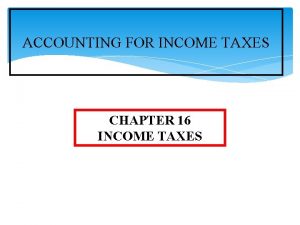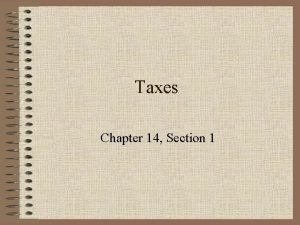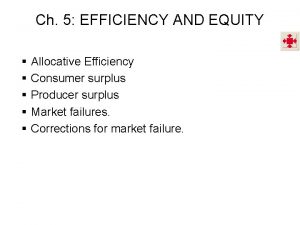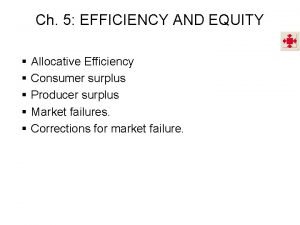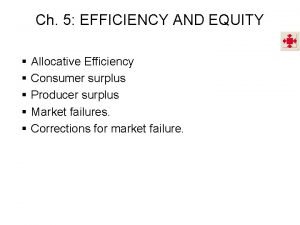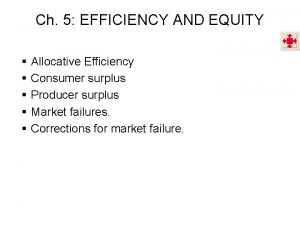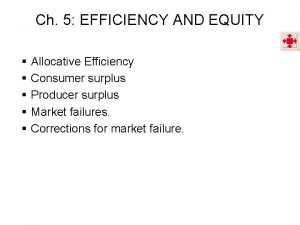Taxes Efficiency and Equity Chapter 7 Efficiency and


































- Slides: 34

Taxes, Efficiency and Equity Chapter 7: Efficiency and Exchange

What is the impact of taxes? n n n On market equilibriums? On efficiency? On distribution? (i. e. who pays them? )

Economic Burden n n The reduction in total economic surplus that results from the adoption of a policy Also known as ‘deadweight loss’

Review of economic surplus: the market for potatoes 6 S Consumer surplus Economic surplus = consumer surplus + producers surplus Price ($/pound) 5 4 3 Producer surplus 2 1 D 1 2 3 4 5 Quantity (millions of pounds/month)

The Effect of a Tax on the Equilibrium Quantity and Price of Potatoes Without a tax P = $3/lb and Q = 3 million lbs/month S + tax S 6 Price ($/pound) 5 With a tax of $1/lb • MC increases by $1/lb • Supply shifts up by $1 • P = $3. 50; Q = 2. 5 million • Consumers and producers share the burden of the tax equally • Producers receive $2. 50/lb • Consumers pay $3. 50/lb 4 3. 50 3 2. 50 2 1 D 1 2 3 4 5 2. 5 Quantity (millions of pounds/month)

The Market for Potatoes Without Taxes 6 5 Price ($/pound) S Total economic surplus = $9 million/month How a tax collected for a seller affects economic surplus 4 3 2 1 D 1 2 3 4 5 Quantity (millions of pounds/month)

The Deadweight Loss Caused by a Tax S + tax S 6 4 Deadweight loss caused by tax 3. 50 3 2 sf e r 2. 50 NOTE: An ad valorem tax would rotate the supply curve upwards Tr an Price ($/pound) 5 1 D 1 2 3 4 5 2. 5 Quantity (millions of pounds/month)

Taxes and Efficiency l How would you determine the impact of a tax on efficiency?

Review of elasticity n Elasticity l n n What is the elasticity of demand for food? What is the elasticity of supply for milk? l n n n A measure of the extent to which quantity demanded and quantity supplied respond to variations in price, income, and other factors. Short run vs. long run What is the elasticity of demand for tropical vacations? For Exxon gasoline? What is the elasticity of supply for land?

Elasticity of Demand the Deadweight Loss from a Tax Deadweight loss 2. 40 2. 00 S+T 2. 60 S 1. 40 D 1 Price ($/unit) S+T S 2. 00 1. 60 D 2 19 24 Quantity (units/day) 21 24 Quantity (units/day) The greater the elasticity of demand, the greater the deadweight loss from a tax

BUT… n The less elastic the demand, the greater share of the tax paid by the consumer. How effective are cigarette taxes at reducing smoking? l How effective are cigarette taxes for earning revenue? l What are the distributional implications of taxes on necessities? l

Differential taxes on inputs n n n E. g. tax on labor vs. tax on capital Makes labor more expensive, capital is used as substitute What happens if we tax capital? l The problem of capital flight

Income tax and efficiency n n Income taxes theoretically change our consumption of work and leisure Theoretically produce an excess burden

Taxes, Externalities and Efficiency n n Externalities are a cost imposed on society by producers Efficiency requires that producers/consumers pay the full cost of production/consumption

Externalities in the Potato market: pesticide applications MC + MEC 6 S= MC Price ($/pound) 5 4 3 2 1 D 1 2 3 4 5 Quantity (pounds/acre/year)

Externalities in the Potato market: pesticide applications S+Tax 6 S= MC Price ($/pound) 5 4 3 2 1 D 1 2 3 4 5 Quantity (millions of pounds/month)

Double-dividend n Taxes on negative externalities are efficient Pollution l Loss of ecosystem services from resource depletion l n Tax bads and use revenue to reduce inefficient taxes on goods

Land Taxes and efficiency What is the elasticity of supply for land?

How do property taxes currently work? n n Tax on combined value of buildings and land. What is the impact on economic efficiency and distribution?

Demand for Land n n n What makes land valuable? Price is determined by demand What determines demand? Basic needs l Factor of production l Speculation l n Rent is major expenditure for poor

Supply and demand of buildings P S 1 CS p 1 PS D q 1 Q

TAX ON BUILDINGS - production cost S 2 P S 1 CS p 2 p 1 Deadweight loss PS tax D q 2 q 1 Q What happens to rent when the supply of buildings shifts?

TAX ON LAND - no production cost S P “Buy land, they ain’t making any more. ” -Will Rogers P* P 1 tax? tax D Q* Q 1 Q What’s the deadweight loss? What’s the impact on speculation?

Impact of shift in land tax n Reduces speculative demand l l n Increases supply of buildings on most valuable land l l n Where is the most valuable land? Rents fall Reduces urban sprawl l n Land prices fall Capitalization theory Bank of America Study No deadweight loss

Subsidies n n n Same basic concept as a tax Distort production incentives Must be paid for, so a subsidy in one place implies a tax in another

What do you think? n What are the efficiency implications of federal subsidies for logging, mining, grazing and oil extraction? l l n n Requires higher taxes elsewhere, and increases negative externalities Are natural resources capital assets? What would be the impact on output of a tax on excess profits (i. e. profits above and beyond a fair return to the factors of production, also known as economic rent? ) Why aren’t taxes being shifted to economic rent?

Taxes and equity n n Who Pays a Tax? Tax incidence l Statutory incidence u Who l is legally responsible for paying? Economic incidence u Who actually pays?

Tax on producers S + tax S 6 4 Deadweight loss caused by tax 3. 50 3 2 sf e r 2. 50 Tr an Price ($/pound) 5 1 D 1 2 3 4 5 2. 5 Quantity (millions of pounds/month)

A tax on consumers S 6 s an Tr 4 Deadweight loss r 3. 5 fe Price ($/pound) 5 3 2. 5 2 D 1 It makes no difference if tax is placed on producers or consumers D after tax 1 2 2. 5 3 4 5 Quantity (millions of pounds/month)

Taxes and equity n Who Pays a Tax? The more inelastic the demand, the more the consumer pays l The more elastic the supply, the more the consumer pays l When supply is perfectly inelastic, the tax falls entirely on the producer l

Elasticity of Demand the Deadweight Loss from a Tax Deadweight loss 2. 40 2. 00 S+T 2. 60 S 1. 40 D 1 Price ($/unit) S+T S 2. 00 1. 60 D 2 19 24 Quantity (units/day) 21 24 Quantity (units/day) The lower the elasticity of demand, the greater the share of a tax paid by the consumer

What do you think? n n n Who pays the social security tax, employees or employers? If the demand for food is inelastic, why is it not taxed in most states? What would be the impact of a gasoline tax on gasoline on equity?

Tax progressivity n What is progressivity? l l n n Are sales taxes progressive? Is the US income tax progressive? l l n Higher marginal taxes? Paying for more than what you get? "Society is responsible for a very significant percentage of what I've earned, " Warren Buffet It takes a village to raise a millionaire What can be said for and against progressive taxes?

Taxes and stability n n High taxes slow down economic growth Stabilization policy Lower taxes when economy is bad l Increase taxes when economy is good l
 Chapter 2 income benefits and taxes
Chapter 2 income benefits and taxes Chapter 14: taxes and government spending section 1
Chapter 14: taxes and government spending section 1 Section 4 best practices of successful people
Section 4 best practices of successful people Chapter 23 understanding income and taxes
Chapter 23 understanding income and taxes Chapter 14 taxes and government spending
Chapter 14 taxes and government spending Flow chapter 2
Flow chapter 2 Chapter 14 taxes and government spending
Chapter 14 taxes and government spending Productive inefficiency and allocative inefficiency
Productive inefficiency and allocative inefficiency Loss contingency journal entry
Loss contingency journal entry Chapter 19 intermediate accounting
Chapter 19 intermediate accounting Allocative efficiency vs productive efficiency
Allocative efficiency vs productive efficiency Productively efficient vs allocatively efficient
Productively efficient vs allocatively efficient State and local taxes and spending
State and local taxes and spending Payroll accounting entries
Payroll accounting entries Value added taxes
Value added taxes Mm proposition ii with taxes
Mm proposition ii with taxes How much did wanda pay in taxes this pay period?
How much did wanda pay in taxes this pay period? How many types of taxes are there
How many types of taxes are there Progressive tax
Progressive tax Classification of tax
Classification of tax Elmira city school district taxes
Elmira city school district taxes Understanding taxes
Understanding taxes Static theory of capital structure
Static theory of capital structure Fin 360
Fin 360 Understanding taxes
Understanding taxes Corrective taxes
Corrective taxes Mm proposition ii with taxes
Mm proposition ii with taxes Paycheck
Paycheck Net operating profit after taxes
Net operating profit after taxes Homemade leverage problems
Homemade leverage problems Wacc
Wacc Government taxes definition
Government taxes definition Taxes in russia
Taxes in russia Depreciation tax shield in capital budgeting
Depreciation tax shield in capital budgeting 3 criteria for effective taxes
3 criteria for effective taxes
